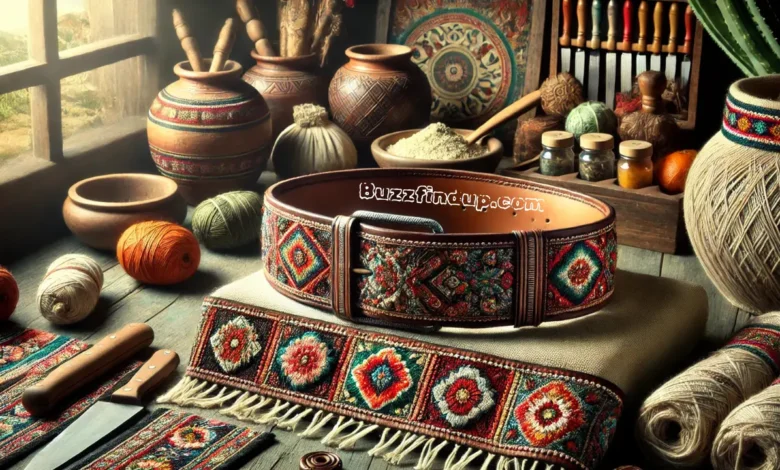Ceñillin: The Timeless Belt of Tradition, Culture, and Fashion

Ceñillin is more than just a belt; it is a powerful symbol of heritage, craftsmanship, and identity. Traditionally worn in various Latin American and Spanish regions, ceñillin represents a unique fusion of artistry and cultural significance. Over the years, this handcrafted accessory has evolved from a traditional garment into a fashionable statement piece, gaining global recognition. In this article, we investigate the origins, cultural importance, craftsmanship, modern adaptations, and the future of ceñillin.
The Origins and History of Ceñillin
The ceñillin traces its roots back centuries, with deep cultural and historical ties to different communities. It was initially crafted as a woven or embroidered belt, primarily worn for practical and decorative purposes. The designs, colors, and patterns of ceñillin often signified regional identity, family heritage, or social status.
Artisans have long used local materials such as leather, wool, and natural fibers to create intricate designs that tell stories through patterns. The craft of making ceñillin has been passed down through generations, preserving traditions that reflect the artistry and dedication of skilled makers.
The Cultural Significance of Ceñillin
Ceñillin holds a profound cultural significance in the regions where it is worn. More than just a functional belt, it symbolizes community, unity, and pride. Here are some of the key aspects of its cultural importance:
Identity and Tradition
Ceñillin is often worn during traditional festivals, ceremonies, and celebrations. It represents regional customs and heritage, and the distinct patterns and colors in each ceñillin piece reflect the unique identity of the community it belongs to.
Storytelling Through Design
Each ceñillin is woven with meaning. Many designs incorporate symbols that represent protection, prosperity, or unity. Local folklore, ancestral traditions, or religious beliefs can inspire these designs.
Connection Between Generations
The process of making ceñillin is an intergenerational tradition. Elders teach younger artisans weaving, stitching, and embroidering techniques, ensuring the craft remains alive. Wearing a ceñillin is often seen as a way to honor one’s ancestors and legacy.
Role in Celebrations and Festivals
In many cultures, ceñillin is a key part of traditional attire worn during significant life events, such as weddings, religious ceremonies, and cultural festivals. It is often paired with colorful garments, creating a visually stunning ensemble celebrating heritage and artistry.
The Craftsmanship Behind Ceñillin
Crafting a ceñillin requires patience, skill, and an eye for detail. The process involves several intricate steps that highlight the artistry of traditional craftsmanship. Here’s a breakdown of how a ceñillin is made:
Selecting Materials
Artisans choose high-quality materials such as leather, wool, or cotton. Sustainable and locally sourced materials are often preferable to maintain eco-friendly production practices.
Weaving and Embroidery
The core of ceñillin’s beauty lies in its weaving and embroidery. Skilled artisans use traditional looms or hand-weaving techniques to create stunning designs. Embroidery, beadwork, or decorative stitching may be added to enhance the visual appeal.
Dyeing and Coloring
Natural dyes derived from vegetation, flowers, and minerals are commonly used to achieve vibrant hues. The choice of colors carries symbolic meanings, often representing aspects of nature, spirituality, or historical events.
Finishing Touches
Once woven, the ceñillin undergoes final refinements, including adding metal buckles, leather accents, or additional embellishments. The final product is a masterpiece of cultural heritage and craftsmanship.
Modern Adaptations and Fashion Trends
While ceñillin has deep traditional roots, it also has a place in contemporary fashion. Designers and artisans have embraced its beauty and versatility, making it a sought-after accessory in modern wardrobes.
Incorporation in Everyday Fashion
Ceñillin is no longer limited to traditional wear. It has become trendy, often paired with casual and formal outfits. People wear it as a belt over dresses, skirts, jeans, and even suits to add a touch of culture and uniqueness.
Sustainable and Ethical Fashion
Ceillin, a natural dye derived from vegetation, flora, and minerals, ceñillin aligns perfectly with the movement. Handmade and ethically sourced ceñillin pieces promote eco-friendly practices and support artisan communities.
Global Influence
The increasing appreciation for handmade and cultural fashion has brought ceñillin into the global spotlight. Many fashion brands collaborate with traditional artisans to create collections celebrating craftsmanship while making ceñillin accessible to international markets.
Social Media and Online Marketplaces
Artisans now leverage e-commerce and social media platforms to showcase their work. This digital exposure has helped ceñillin reach a wider audience, making it more straightforward for people worldwide to appreciate and purchase authentic pieces.
How to Choose and Care for Your Ceñillin
Owning a ceñillin is a way to celebrate culture, but it’s also essential to care for it properly. Here are some tips to ensure its longevity:
Choosing the Right Ceñillin
- Look for handcrafted pieces made by skilled artisans.
- Consider the leather, wool, or fabric material to match your style and needs.
- Pay attention to details such as embroidery, patterns, and durability.
Proper Storage
- Store in a cold, dry place to prevent damage.
- Please keep it away from direct sunlight to maintain color vibrancy.
- Avoid folding tightly to prevent creases and wear.
Cleaning and Maintenance
- For fabric ceñillins, gently hand wash with mild soap and cold water.
- Leather ceñillins should be cleaned with a damp cloth and treated with leather conditioner.
- Avoid using harsh chemicals that may injure delicate embroidery or stitching.
The Future of Ceñillin: Preservation and Innovation
The future of ceñillin lies in the balance between tradition and innovation. Efforts to preserve this cultural gem include:
Supporting Artisan Communities
Purchasing authentic ceñillin from artisan cooperatives and fair-trade organizations helps sustain traditional craftsmanship and provides livelihoods to artisans.
Educational Workshops and Cultural Events
Workshops teaching the art of ceñillin weaving ensure that younger generations continue the craft. Cultural events and festivals also play a vital role in keeping traditions alive.
Collaboration with Designers and Brands
Partnerships between traditional artisans and contemporary fashion designers help bring ceñillin into the modern fashion scene, making it more accessible and desirable.
Digital Storytelling and Awareness
Social media campaigns, documentaries, and online platforms dedicated to cultural heritage can help promote ceñillin to global audiences, ensuring its continued appreciation and demand.
Conclusion
Ceñillin is a testament to the beauty of tradition, craftsmanship, and cultural pride. From its origins as a functional belt to its place in modern fashion, ceñillin continues to evolve while remaining true to its roots. Whether worn as a symbol of heritage or stylish accessory, ceñillin remains an enduring piece of art that connects generations and cultures. We preserve this timeless tradition for future generations by supporting artisans and embracing handmade craftsmanship.



